
Interior of the Samuel Clement House
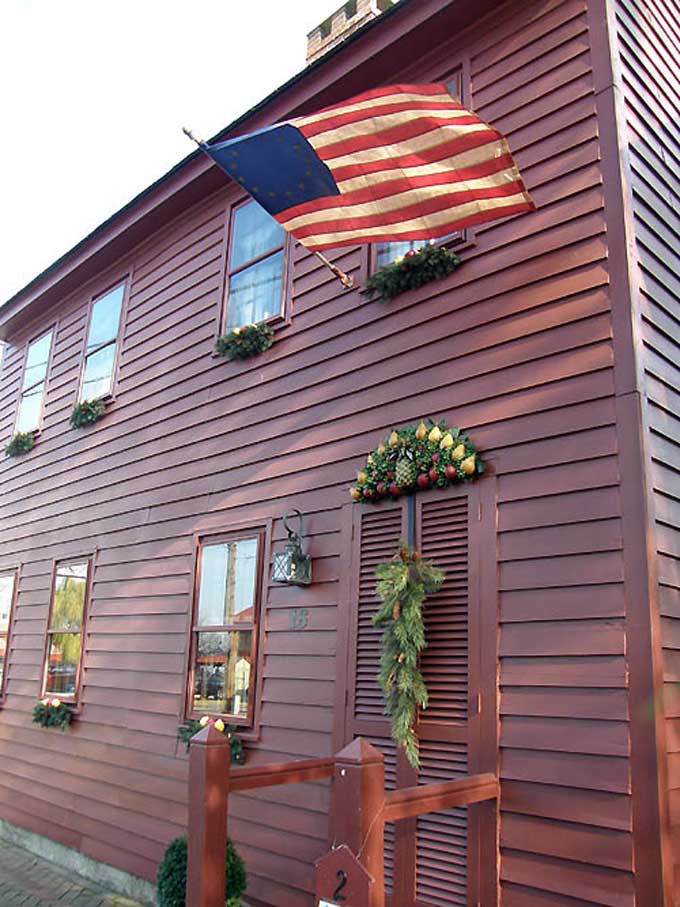
The Saltbox built in 1825
Thirty two years earlier in 1643 the Swedish Governor, Johan Prinz, constructed Fort Nya Elfsborg to guard the profitable fur trade established by the Swedes. Salem County happened to be military capital which stretched from Woodbury to Cape May. At that time the area was mostly swamp land, and the fort was commonly named Fort Myggenborgh (Fort Mosquito). The soldiers at the fort were inundated with mosquitos and the fort eventually was burned down in 1655. Thirteen soldiers provided security for Fort Nya Elfsborg which had brass 12pd cannons mounted on earth and wooden palisades. It was a earthen redoubt with three corners normally built by the Swedes. Eight guns defended the position. Log farmsteads were placed strategically up the river from the fort. The Dutch West India Company ships coming up from the bay would have to get by them first.

A lady keeping the fire going in the log cabin at Johan Printz Memorial Park
The English finally took control in 1664 when Richard Nicolls who commanded the British fleet sailed into New Jersey and what is currently the Port of New York and threatened to attack. The Dutch had no choice but to surrender their colony. This was the same year that New Jersey received its name as a state from the British Isle of Jersey by James Stuart, the Duke of York.

A Revolutionary War soldier demonstrating the use of a cannot at Johan Printz Memorial Park
Fenwick refused to abide by the decision. His ultimate decision was to organize a colony of settlers and settle on land called Fenwick's Colony now known as Salem. He issued land patents, enforced his own laws and became governor. Billinge countersued which led Fenwick to land in prison several times for the next decade.
Salem played a hidden role, a bloody massacre in the American Revolution that many people don't know about. New Jersey people were divided into three parts; one-third of the people supported the rebels, one-thirds supported the British, and one-third were neutral. New Jersey declared itself an independent state by joining the colonial uprising.
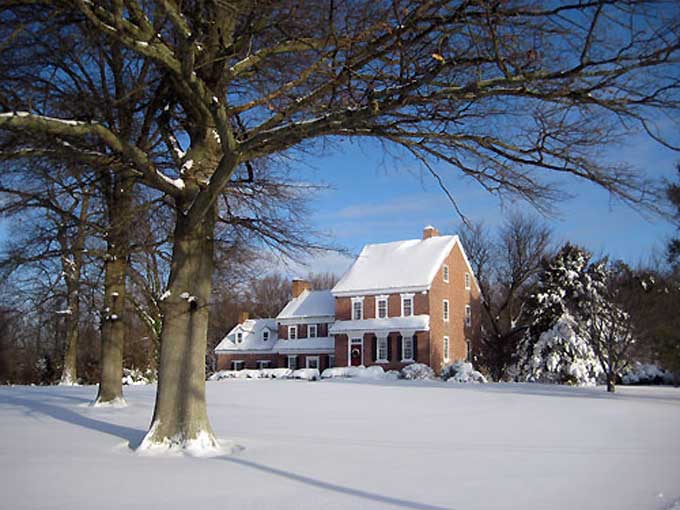
Holmeland, the Home of Benajmin Holme, photo courtesy of Suzanne Cook/Carol Reese
The British were frustrated and upset because they didn't take control of Quinton's Bridge and for the support the Salem County people provided to the Continental Army. They decided to turn their sights towards Hancock's Bridge. This brings us to our first house on the tour this year. Unfortunately it was the scene of a deadly massacre. Mawhood gave the following mandate to his British troops: "Go - spare no one - put all to death - give no quarters." The massacre occurred at Judge William Hancock's house.

The Hancock House
The Hancock House was built by Judge William Hancock and his wife Sarah in 1734. The exterior of the house was modeled after the seventeenth century building traditions that the Quakers used in their homeland. Masons alternated red brick laid lengthwise, called stretchers, with blue glazed bricks laid on end, referred to as headers. The name is commonly referred to as a Flemish Bond pattern. Salem County has the second largest concentration of patterned brick houses in New Jersey. The W,H,and S initials stand for William and Sarah Hancock. A pent roof wraps around the front and back of the house. It has simple entrance steps and uses local materials such as Wistarburg glass.
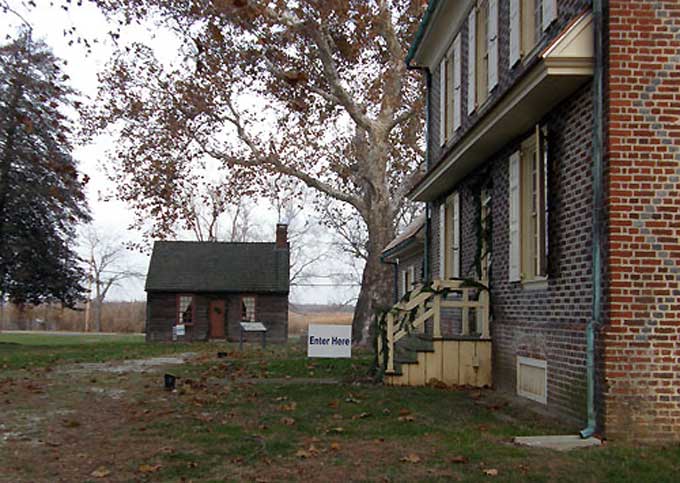
The Swedish Cabin on the premises of the Hancock House
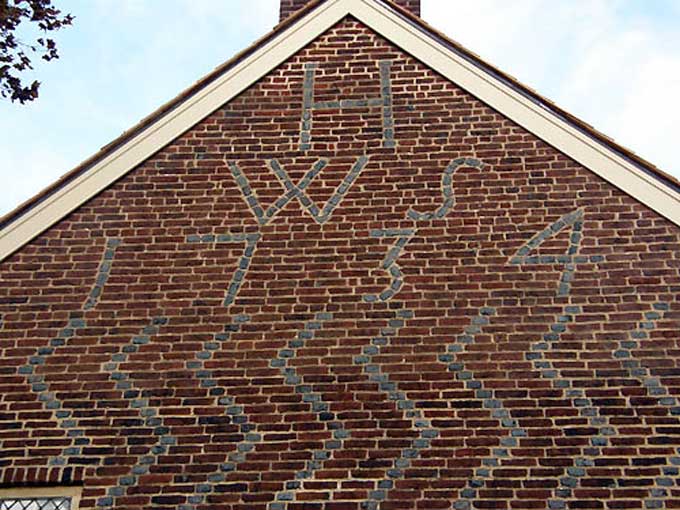
Flemish Bond pattern used with brick on the exterior of the Hancock House
Ken and Debbie Gralley welcomed us the the Richard Johnson House. We found it amazing that the oldest part of the home was constructed in 1687. The brick addition was added around 1840. Ken knew he had to buy the property when has walked in the house and saw the wide plank floors that were used. Hanging on the mantle was a Brown Bess gun handed down in the Gralley family. Attached to it was a seventeen inch triangular cross section bayonet which Ken said was outlawed because of the damage it had cause to a person.

The Richard Johnson House, the earliest portion built in 1687
Another home on tour for the first time in Elsinboro was Homleland owned by Brian and Barbara Duffy. The earliest portion of the building is believed to have been built in 1729. The property and 1,600 acres were purchased by Benjamin Holme from the Redroe Morris estate in 1762. Holme was a Whig who served as a Colonel in the South Jersey Militia during the American Revolution. Colonel Holme was involved in the skirmish at Quinton's Bridge. Holme had his troops placed in the trenches along Alloway Creek. They were able to make the British forces retreat after engaging them with destructive fire. Lord Howe offered £100 to either capture or kill Holme. Holme was not captured.

Holmeland, photo courtesy of Suzanne Cook/Carol Reese
There were three men, Jones, Loyd, and John Gibbon, who were captured and sent to New York as prisoners. John's wife Esther Seeley Gibbon was given permission to visit her husband in New York. Unfortunately here husband had died three days earlier of starvation. She spotted the Holme clock and told Colonel Holme upon her return to Salem. Ironically Benjamin and Esther married October 28, 1778.
After the war in 1783, Colonel Holme went to New York and brought the clock back on an ox cart. The next year he added the taller eastern wing. A niche was provided in the ceiling to allow for the height of the clock.

The Matlack House built in 1868, photo courtesy of Suzanne Cook/Carol Reese

Ten Gables House built in 1890, photo courtesy of Suzanne Cook/Carol Reese
Founded in 1884, the Salem County Historical Society is one of the oldest historical organizations in southern New Jersey. The Salem County Historical Society is a complex of historic buildings built between 1700 and 1800.

The Salem County Historical Society

The John Jones Law Office built in 1735 is also in the rear of the Salem County Historical Society

The Log Cabin in the back of the Salem County Historical Society
The Historical Society maintains manuscripts, historic books, documents, photographs, and a microfilm library. It has set up an exhibition of period furnishings, textiles, Wistarburg glass, furniture of the period and decorative arts. The Wagstaff Holme clock is also housed in the facility.

The interior of the Clement Acton House built in 1818
The Peter Barnart House which was built in 1800 was a Federal clapboard colonial home with Victorian renovations. At one time the home belonged to Bacon Ware, a famous watch and clockmaker in the Salem County area. The home now serves as law offices for Helen Petrin. She and her husband Michael are the current owners. We were welcomed to Christmas carols being played on the 1864 baby grand piano.
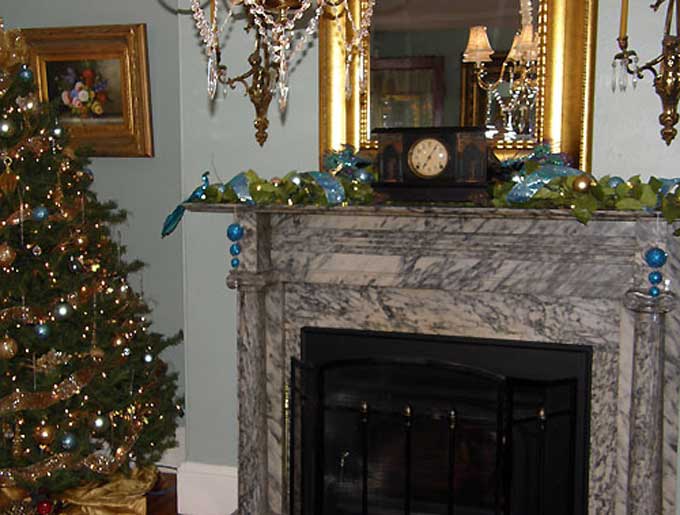
The marble fireplace at the Richard Woodnutt House

Mantle in the John Wistar House built in 1790
The John Wistar home was built in 1790 on land purchased from Dr. Ebenezer Howell in 1780. John bought the home in 1812 and enlarged the home in the Federal style design in 1814. The current owners, Bill and Mary Breneman bought the home when it was condemned. The windows were boarded up and plaster had fallen from all the walls and ceiling. They removed many Victorian designs from the home to return it to its Federal architecture.

Diane Wohlrab greeting guests at the Samuel Clement House
The clapboard house owned by Debbie and Andrew Bee was an original double house built in 1825 for two families. It was a salt box colonial like so many New England homes. It once served as servants' quarters. There are currently four original working fireplaces. It was transformed into a single family dwelling between 1977 and 1981. The collection of painted grain bins and furniture, stoneware, yellow ware, coverlets and quilts, the home had a wonderful country home feel that many people strive to create.

43rd Regiment of Foot
The James Barrett House is located in Mannington. James Barrett, A Quaker from Burlington, was believed to have purchased the land the house stands on in 1694 from Hypolyte Le Fevre. The Georgian style brick house was built by a member of the Barrett family. The front portico and wooden keystones were added in the Greek Revival period and a wooden structure was moved next to the brick house which served as a kitchen until 1991. The new addition was added. Craig and Gaynel Schneeman visited the home in 1977 on a Salem County House Tour. They purchased the home 25 years later and have been doing the restoration ever since.

The James Barrett House in Mannington, photo courtesy of Suzanne Cook/Carol Reese

Fireplace at the Josiah Miller House in Mannington, photo courtesy of Suzanne Cook/Carol Reese
Nothing is more colonial than a wayward tavern. Heinrich Gudehus in our journal section of Colonial Sense stayed in a few on his trips throughout Pennsylvania. Mannington has its own tavern, the Sign of the Seven Stars. There was an earlier log cabin on the property which was replaced by a brick house built by Peter and Elizabeth Louderback in 1762. The date does appear along with the initials of the original owner on the south gable. In 1807 a Quaker family bought the tavern and closed it for business. As in many colonial taverns there is a birdcage bar and a walk-in fireplace. Joe and Susan Frank are the current owners.
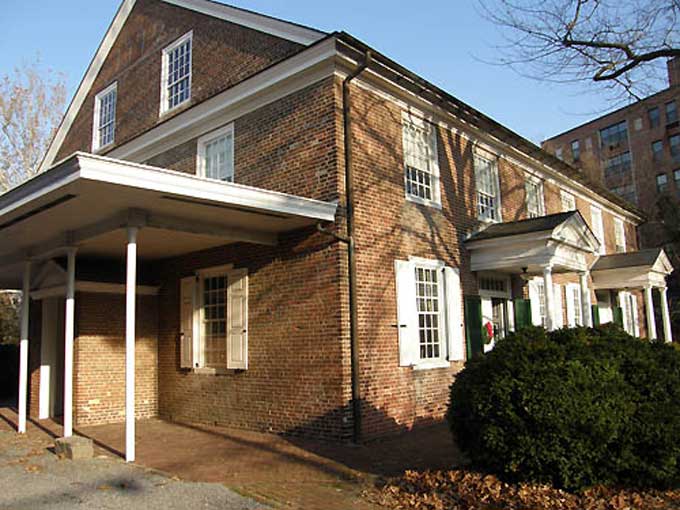
The Religious Society of Friends Meeting House built in 1772.
Royal Port Antiques, formerly Waddington Grain Storage Building next door to Prinz Memorial Park was opened for refreshments and shopping. Suzanne Cooke who is on the Yuletide Tour Committee is instrumental in updating the Salem House Tour on Facebook. Her efforts encouraged us to make our first trip to Salem.
We hear that the turnout was fantastic this year. Some of the owners said they easily had hundreds of people from New York, Pennsylvania Maryland, and Delaware in their houses. The warm weather helped bring out the crowds.
The state of New Jersey has many ties to the colonial era, and there is plenty of architecture to keep the colonial enthusiast busy. Salem is one of the areas not to be missed. You can either visit on a Spring or Yuletide Tour in December. This is a tour not to be missed, so make sure you visit Salem.
Source: Research, photos & text by Bryan Wright (except where indicated)



